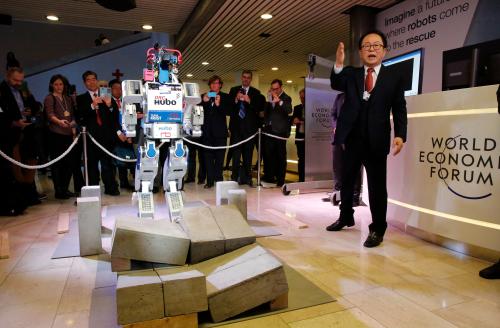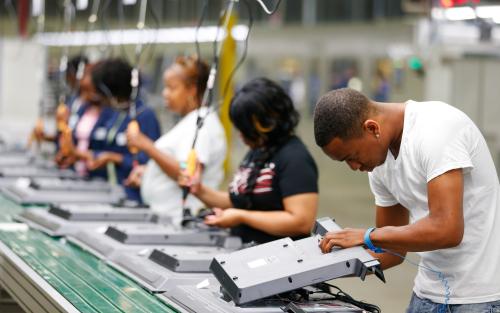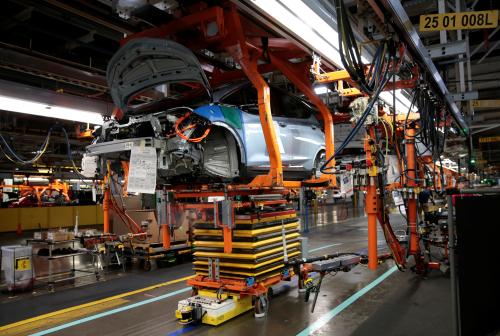Technology is shaking up labor markets around the world. Increasingly intelligent machines are taking over routine jobs. Three-D printing is making many traditional, labor-intensive production processes obsolete. In total, almost half of all jobs may be at risk in the United States due to automation. Job losses are no longer just limited to blue collar occupations, but increasingly also affect high-paying white collar jobs such as in insurance, in the health sector or even in government bureaucracies. Is this the end of work as we know it? Not so fast, say some, who argue that technological progress and automation have not necessarily led to less demand for work on aggregate. An often cited example is the fact that the introduction of the automatic teller machine was accompanied by an expansion in retail banking jobs as banks opened more branches.
While technology and people may work hand in hand, automation is triggering significant displacement of workers. Technology is making work less manual and routine and more interactive and creative-cognitive. Not all those who lose routine jobs will find new non-routine, interactive, and creative-cognitive jobs—not immediately and perhaps never. Age matters: In the fast-changing 21st century jobs market, workers need strong cognitive and social skills to do increasingly creative work and to become successful lifelong learners. But middle-aged and older workers in emerging and advanced economies are often poorly prepared: According to evidence from Organization for Economic Cooperation and Development countries they are less likely than younger workers to have strong problem-solving skills and to have experience in using computers.
Figure 1: Problem-solving proficiency: Much higher among younger than older adults (OECD average, 2012 and 2015)
Source: OECD (2016), Skills Matter: Further Results from the Survey of Adult Skills.
Note: Levels 2 and 3 are the top two proficiency levels for problem solving in technology-rich environments in PIAAC.
How can governments respond? First, workplace automation dictates an all-out effort to upskill the workforce. To prepare for the age of automation, governments need to modernize education to boost cognitive and social skills of future labor market entrants, especially among children from disadvantaged socio-economic backgrounds who often fall behind. But upskilling today’s adult workforce is far trickier. The critical window to acquire cognitive skills ends with early adulthood. This means that upskilling existing mid-aged and older workers will be harder for those who lack the cognitive foundation skills to be effective lifelong learners. While there is scope to modernize training provision with new methods and technology, the record of lifelong learning and adult retraining is often poor, especially for older and less educated workers.
Universal basic income or publicly subsidized jobs?
If their skill gaps cannot be sufficiently bridged, many middle-aged and older workers risk losing out in the technology-driven economy. How can they make ends meet if not through labor income? The revolution in the world of work is bringing to the fore revolutionary ideas. Take the unconditional universal basic income. While the Swiss rejected the introduction of a universal basic income in a referendum last year, Finland is now piloting such a program, and the “revenu universel” is a prominent topic in France’s presidential election debates. Unusually, it has the support of politicians of different colors, trade unions and Silicon Valley’s tech world alike. At its core, the idea is that all adults would be entitled to an unconditional cash transfer, which would make up for lost or reduced labor income and allow people to pursue other activities. The idea of universal basic income remains controversial for many reasons, but one criticism stands out: Unconditional cash risks making people passive. Instead, people value work not just for the income it provides but also for the status and dignity that comes with it.
As governments look for fresh ideas on how to support the losers from automation, publicly supported jobs should be examined first. Public works programs have often been criticized for not improving their beneficiaries’ employment probability. But in the age of automation they need to be assessed not just against the traditional objective of returning the unemployed to private sector employment. Looking ahead, the case for public works programs rests equally on an argument of social inclusion and societal stability as they provide the losers from automation with a chance to earn their living and continue to make an active contribution to public life. While their traditional emphasis has often been on manual, menial jobs not much aligned with workers’ skills and public needs, the age of automation could herald a new generation of public works with societal value: take, for example, jobs in child or elderly care where needs are rising fast with population aging or in community-based prevention of crime and violence. Work may replace work, after all.
The Brookings Institution is committed to quality, independence, and impact.
We are supported by a diverse array of funders. In line with our values and policies, each Brookings publication represents the sole views of its author(s).









Commentary
Replacing work with work: New Opportunities for workers cut out by automation?
February 21, 2017